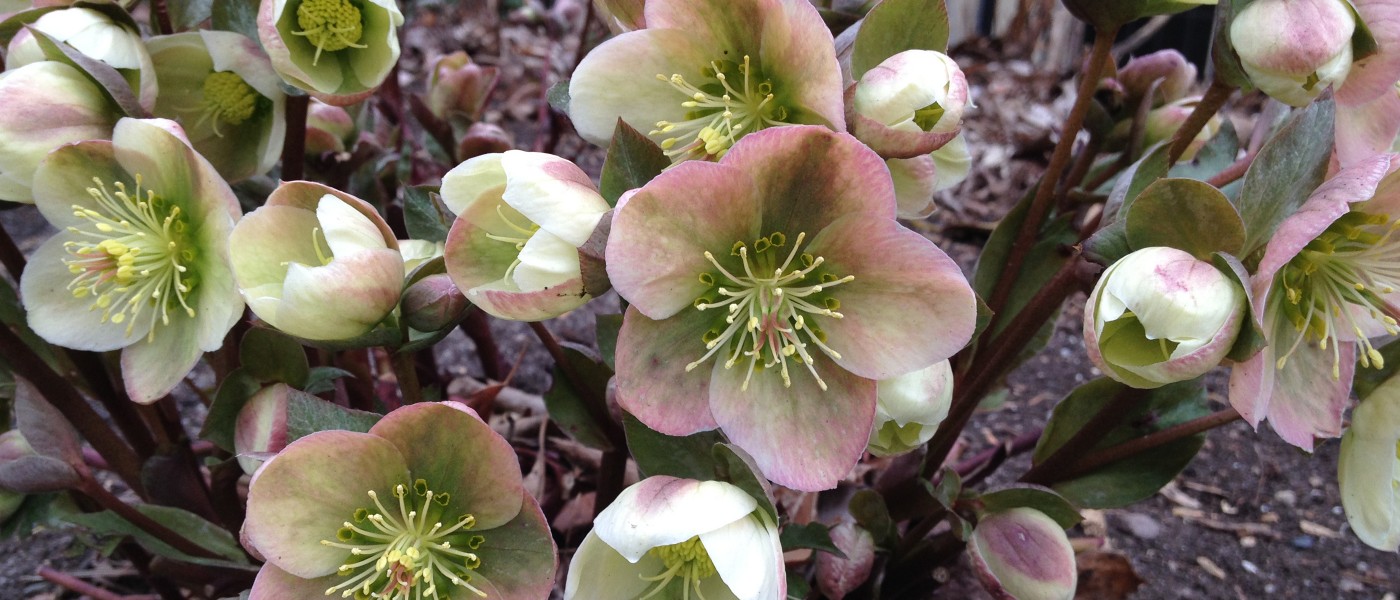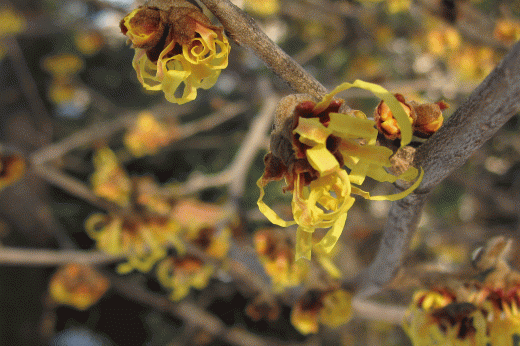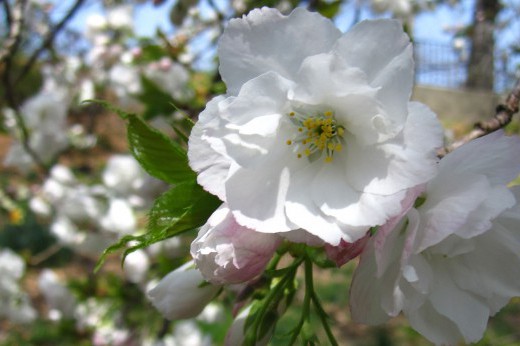I will always find a spot for hellebores in my garden. They mark the changing of the seasons and help pass a time of year that seems particularly long. I welcome their sunny faces from November until April, peeking out of shady (or partially sunny) corners of in the garden.
The Helleborus genus is one of the highlights in the Early-Spring Garden, at the south end of Brooklyn Botanic Garden, along with witch-hazels, winter hazels, snowdrops, Japanese camellias, and early-blooming viburnums. Already, the first hellebores there are poking their heads out of little mounds of foliage.
Until about 30 years ago, hellebores were uncommon in home gardens, but they now have a place in every good perennial nursery. They are a delicate but tough plant, forgiving enough to thrive in a small, partially shady New York City garden.
Hellebores are perennials in the buttercup family (Ranunculus). Native to Eurasia, they are well suited to our climate and are hardy in USDA Zones 4 or 5, depending on the species and variety. When it gets cold, it is their time to shine.
This plant blooms from late November through winter until spring, depending on the species or hybrid. The leaves provide a nice carpet of foliage throughout the year—some are shiny green, others have a light patterning on the leaves, and some are dark and leathery. Come summer, many hellebores start to look peaked (like I feel in the hot and dry summer!), but they perk up and send out tender fresh foliage in September and October, once the weather cools down, and, ideally, ample rain falls.
Hellebore blossoms last a long time, making them a favorite of florists, and though the sepals (the correct botanical name for these colorful petals) will fade slightly, they persist on the plant for well over a month.
The snow-white rose, or lily’s virgin bell,
The fair HELLEBORAS attractive shone,
Warm’d every Sage, and every Shepherd won.
—Erasmus Darwin, The Botanic Garden, 1791
People often ask which pollinators visit these plants during winter, and the answer is, not many. Helleborus species are native to Europe and Asia, and there are no known native pollinators here. The early-spring flowers, however, can be an emergency source of food for insects if other native plants aren’t blooming yet. It’s common to see a stray bee or fly stop by while foraging for nectar on a warm sunny day.
A note about the name: Helle- comes from the Greek helein: “to injure”; -bore comes from the Greek word for food. Taken together, this means that a hellebore will injure you if you eat it! All parts of this plant are toxic if ingested.
Cultivating Hellebores
It’s always best to buy hellebores when they’re in bloom, so you know exactly what color and form of flower you’re getting. Some of the species hellebores (like Helleborus foetidus) can be grown from seed, but they are slow growers, so it’s usually best to buy them as full-size plants from a nursery or plant store. Fall is the best time to plant, but they can go in whenever the ground isn’t frozen—ideally from September to June. They will be under more stress in the summer, so try to avoid planting then.
Once established, hellebores like moist soil and a “haircut” of their annual leaves. Otherwise, they are relatively easygoing and need little maintenance. The haircut improves air circulation around the plants and also highlights the blooms. I enjoy moving from plant to plant, snipping off the leathery older leaves and any that are blackened, damaged, or have fungus. Only new leaves and perhaps flower shoots emerging from the ground remain. This task can be done anytime from November through March.
Upon planting, hellebores should be watered regularly each week during the growing season for the first year. After that, water as needed to keep the soil moist but not wet. They appreciate a side dressing of compost every couple of years, but a heavy mulch will not suit them.
In our Early-Spring Garden at BBG, the hellebores are featured especially well, with a literal leg up on the competition. That is, the delicate and petite blooms, which are often downturned, are better appreciated on a hill or in a tall container. Many of the bred hellebores you find these days have upturned blossoms, but I still welcome a closer glance on an incline.
Species and Cultivars
There are many hellebore species, cultivars, and hybrids to choose from. Below is a selection from my garden that would provide blooms from November until spring bulbs start blooming.
Christmas-Rose
Helleborus niger
The first of the hellebores to bloom is Helleborus niger, the Christmas-rose, so-called because it blooms around Christmastime and has a flower arrangement that looks similar to that of a rose. There are many worthy cultivars to choose from, but one I grow and particularly like is ‘Praecox’. It’s an early bloomer (starting in mid-November in Brooklyn) that lights up the hillsides when it blooms and fades to pink as it ages. Christmas-roses thrive in partial sun and well-draining soil.
Stinking Hellebore
Helleborus foetidus
Flowers of this species appear in January around the same time that you can also enjoy the velvety buds of the paperbush and the witch-hazels. Both the Latin and common names make this species sound awful, but its pungent smell is only released when the foliage is cut or crushed. The light green flower stalks are up by January, even under a layer of snow, and the cups start opening in February, a great respite for the stray bee or fly out looking for nourishment on a warm day.
This species is easily grown from seed. Plants take about three years to reach their mature size, and the clumps will spread slowly. In my area, I let the plants go to seed around the parent plant. That way I will get new volunteer plants every year that I can transplant as I wish.
Lenten-Rose
Helleborus × hybridus
The last of the bunch start blooming in February and continue through to April. These are the Lenten-rose cultivars, named for their bloom time, around Easter. The group includes one of my favorites in the early-spring garden—Helleborus × hybridus ‘Cherry Blossom’—along with the other cultivars in the Winter Jewels series. The flowers are speckled and edged with a dark cherry red; the insides fade to the lightest pink.
Again, as with any of the hellebore cultivars, buy this plant in early spring, when it’s blooming, so you know exactly what color the flowers will be. These plants can be divided and transplanted after a couple of years’ growth, and it’s easy to multiply your good clumps once you have them established.



